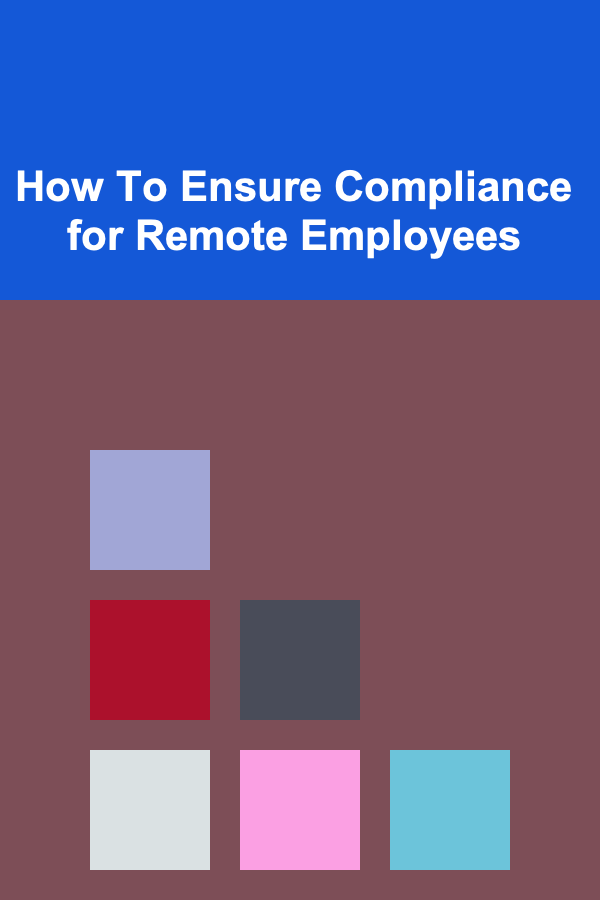
How To Ensure Compliance for Remote Employees
ebook include PDF & Audio bundle (Micro Guide)
$12.99$7.99
Limited Time Offer! Order within the next:

In the modern workforce, remote work is becoming increasingly common. As organizations expand across borders and embrace flexible work arrangements, the issue of compliance for remote employees has emerged as a critical concern. Ensuring that remote employees adhere to the company's policies, legal regulations, and industry standards is paramount, as failure to comply can lead to significant risks such as legal liabilities, financial penalties, and reputational damage.
In this article, we will explore how organizations can ensure compliance for remote employees. We will delve into the legal aspects of remote work, best practices for developing compliance frameworks, technological solutions for monitoring and enforcement, and how to cultivate a compliance culture within a distributed workforce.
Understanding Remote Employee Compliance
1.1 What is Remote Employee Compliance?
Remote employee compliance refers to the adherence of remote workers to both internal company policies and external legal regulations. These may include:
- Labor Laws: Regulations regarding working hours, compensation, and benefits, which can vary by jurisdiction.
- Data Security: Compliance with privacy laws such as GDPR, HIPAA, and CCPA to ensure the protection of sensitive data.
- Health and Safety: Ensuring a safe work environment, even when employees are working from home or other remote locations.
- Tax Compliance: Ensuring that remote workers are being taxed correctly, particularly when they are working from different states or countries.
- Intellectual Property Protection: Safeguarding company intellectual property and proprietary information in a remote setting.
1.2 Why is Remote Employee Compliance Important?
Ensuring compliance for remote employees is essential for several reasons:
- Legal Risks: Non-compliance with labor laws or data protection regulations can result in legal consequences, including lawsuits, fines, and penalties.
- Financial Penalties: Failing to follow tax regulations or misclassifying workers can lead to severe financial penalties.
- Reputation Management: Compliance failures can damage an organization's reputation and lead to a loss of trust among customers, partners, and potential hires.
- Employee Well-Being: A lack of clear compliance can also affect employee well-being, as they may not be properly informed of their rights and responsibilities.
Key Compliance Areas for Remote Employees
Ensuring compliance for remote employees involves focusing on several critical areas. Below are some of the most important compliance concerns organizations need to address:
2.1 Labor Laws and Employment Contracts
Remote employees, like in-office workers, are entitled to rights and protections under labor laws. However, these laws can vary greatly depending on the jurisdiction in which the employee is based. Remote employees may work in different states or even countries, each with its own labor laws.
Best Practices:
- Clear Contracts: Employment contracts for remote workers should specify terms related to work hours, pay, benefits, and other employment conditions. This helps clarify expectations and ensures both the employer and employee are on the same page.
- Knowledge of Local Laws: Employers must stay informed about the labor laws in the jurisdictions where remote workers are based. For example, some countries or states may have strict rules about overtime pay or mandatory benefits.
- Time Tracking Systems: Use reliable systems to track working hours, ensuring compliance with minimum wage laws and overtime regulations. This is especially important when employees work in different time zones.
2.2 Data Privacy and Cybersecurity
Remote employees often have access to sensitive company data, making data privacy and cybersecurity a major concern for compliance. Breaches of personal data can result in severe penalties under laws like GDPR (Europe), CCPA (California), and HIPAA (U.S. healthcare).
Best Practices:
- Data Protection Training: All remote employees should undergo regular training on how to handle sensitive data and maintain cybersecurity standards.
- Use of Secure Devices: Organizations should provide remote employees with secure, company-approved devices and software to minimize the risk of data breaches.
- VPN and Encryption: Remote workers should be required to use virtual private networks (VPNs) and encrypted communication tools when accessing company data, especially when working from public or shared networks.
2.3 Tax Compliance and Payroll
Tax compliance can be particularly challenging for organizations with remote employees in multiple jurisdictions. Different states or countries may have different tax rates, payroll requirements, and withholding regulations.
Best Practices:
- Understanding Tax Jurisdictions: It's essential for employers to be aware of the tax rules in each jurisdiction where their remote employees are located. This includes both income tax and employer payroll taxes.
- Hiring a Global Payroll Service: For international remote workers, companies should consider using a global payroll service that can handle the complexities of tax compliance across multiple countries.
- State-Specific Taxation: In countries like the U.S., state-specific taxes and rules about income tax withholding are crucial to understand. Remote employees who work in different states may be subject to different tax rates.
2.4 Health and Safety Regulations
Even though remote workers may not work in a traditional office environment, employers are still responsible for ensuring that their workers have a safe and healthy workspace. This can include ensuring ergonomic workstations, preventing work-related stress, and addressing mental health issues.
Best Practices:
- Home Office Guidelines: Provide employees with guidelines on how to set up a safe and comfortable home office, including ergonomic furniture and safe working practices.
- Mental Health Support: Offer access to employee assistance programs (EAPs) that provide counseling or mental health services, particularly since remote work can lead to isolation or burnout.
- Accident Reporting: Even in remote settings, companies should have a system in place for reporting accidents that occur while employees are working from home, particularly if the accident results in an injury.
2.5 Intellectual Property and Confidentiality
Remote workers may have access to sensitive intellectual property (IP) or proprietary business information. It is critical to establish strong protocols to protect the company's intellectual property and maintain confidentiality.
Best Practices:
- Non-Disclosure Agreements (NDAs): All remote employees should sign NDAs to protect proprietary information.
- Secure File Sharing Systems: Use secure cloud-based file-sharing and collaboration platforms that ensure confidential information is kept safe.
- IP Ownership Clauses: Ensure that contracts include clauses that specify the company's ownership of any intellectual property created by remote employees during their employment.
Technological Solutions to Ensure Compliance
Technology plays a vital role in ensuring remote employee compliance. With a dispersed workforce, it's essential to leverage the right tools to manage compliance effectively.
3.1 Employee Monitoring and Time Tracking
Using employee monitoring and time tracking software can help ensure that remote workers are adhering to company policies, such as working the appropriate number of hours or maintaining productivity.
Best Practices:
- Transparent Monitoring: Ensure that remote employees are aware of the monitoring tools in place. Transparency builds trust and avoids potential legal concerns related to privacy.
- Performance Metrics: Instead of focusing on how much time employees spend working, it can be more effective to monitor productivity through specific performance metrics aligned with the company's goals.
3.2 Compliance Management Software
Compliance management software can assist organizations in tracking and managing compliance tasks for remote employees. These tools help automate compliance audits, track employee certifications, and ensure that employees are following internal policies.
Best Practices:
- Automate Reminders: Use software that sends automated reminders for tasks like employee training, certification renewals, or policy updates.
- Audit Trails: Maintain clear and comprehensive audit trails of compliance activities to provide documentation in case of an audit.
3.3 Secure Communication Tools
Ensuring compliance in remote work environments requires robust communication tools that are secure and protect sensitive data. Email, messaging platforms, and video conferencing tools must be encrypted and safeguarded against cyber threats.
Best Practices:
- End-to-End Encryption: Use communication tools that provide end-to-end encryption to protect sensitive conversations and data exchanges.
- Access Control: Restrict access to confidential information based on employee roles and responsibilities.
Building a Culture of Compliance
One of the most effective ways to ensure compliance for remote employees is to cultivate a culture of compliance. When compliance becomes ingrained in the company's culture, employees are more likely to follow the rules and understand their responsibility to uphold organizational standards.
4.1 Employee Training
Regular training on compliance topics is essential to help remote employees understand their responsibilities and the rules they must follow. This includes topics such as data privacy, workplace safety, intellectual property, and ethical conduct.
Best Practices:
- Regular Workshops: Organize periodic workshops or webinars to keep remote employees updated on changes to laws, regulations, and internal policies.
- Interactive Learning: Offer interactive e-learning modules that test knowledge and ensure employees understand the compliance expectations.
4.2 Clear Communication
Effective communication is critical to maintaining a compliance-driven culture. Employers should clearly communicate the company's compliance policies and expectations to all remote workers.
Best Practices:
- Clear Guidelines: Provide easily accessible compliance manuals or handbooks outlining the company's expectations and legal requirements.
- Open Channels: Maintain open communication channels so remote employees can ask questions and receive clarification on compliance-related issues.
4.3 Lead by Example
Leadership plays a crucial role in setting the tone for compliance. When executives and managers prioritize compliance and demonstrate a commitment to ethical behavior, employees are more likely to follow suit.
Best Practices:
- Top-Down Approach: Encourage leaders to set a strong example by adhering to compliance standards and addressing any violations promptly.
- Promote Accountability: Hold all employees, regardless of their role, accountable for compliance, creating an environment where everyone understands their responsibility to follow the rules.
Conclusion
Ensuring compliance for remote employees is a multifaceted challenge that requires a combination of legal knowledge, effective technology solutions, and a strong culture of accountability. Organizations must stay informed about local and international regulations, invest in the right tools for monitoring and enforcement, and foster a culture where compliance is prioritized at all levels. By implementing clear policies, leveraging technology, and maintaining an ongoing commitment to compliance, companies can successfully navigate the complexities of remote work while mitigating the risks associated with non-compliance.
Reading More From Our Other Websites
- [Home Pet Care 101] How to Keep Your Dog from Barking Excessively
- [Rock Climbing Tip 101] How to Build Strength and Flexibility for Indoor Climbing Success
- [Home Staging 101] How to Stage Your Home to Sell in a Buyer's Market
- [Star Gazing Tip 101] Myth vs. Reality: Folklore and Facts About the Moon's Phases
- [Scrapbooking Tip 101] Best Practices for Using Vintage Ephemera in Contemporary Scrapbook Designs
- [Personal Investment 101] How to Invest in Foreign Currencies for Currency Diversification
- [Home Holiday Decoration 101] How to Decorate Your Home for the Holidays with Kids in Mind
- [Sewing Tip 101] Speed Quilting Techniques: How to Finish Projects Faster Without Sacrificing Quality
- [Home Renovating 101] How to Use Smart Home Technology in Your Renovation
- [Home Pet Care 101] How to Introduce Your Pet to a New Baby or Child

How to Organize a Pet-Friendly Kitchen for Safety and Convenience
Read More
How to Save on Home Security Without Compromising Safety
Read More
How to Design a Biotope Aquarium for Native Fish
Read More
How to Build a Personal Archive of Ephemera
Read More
How to Optimize Your React Application for Performance
Read MoreBill Trackers for Small Business Owners: A Comprehensive Guide
Read MoreOther Products

How to Organize a Pet-Friendly Kitchen for Safety and Convenience
Read More
How to Save on Home Security Without Compromising Safety
Read More
How to Design a Biotope Aquarium for Native Fish
Read More
How to Build a Personal Archive of Ephemera
Read More